sensor TOYOTA LAND CRUISER 2013 J200 Owner's Manual
[x] Cancel search | Manufacturer: TOYOTA, Model Year: 2013, Model line: LAND CRUISER, Model: TOYOTA LAND CRUISER 2013 J200Pages: 720, PDF Size: 21.46 MB
Page 233 of 720

233 2-4. Using other driving systems
2
When driving
LC200_OM_OM60F57U_(U)■Buzzer operation and distance to an obstacle
A beep sounds when the corner sensors and rear center sensors are
operating.
●The buzzer beeps faster as the vehicle approaches an obstacle.
When the vehicle comes within the following distance of the obsta-
cle, the buzzer sounds continuously:
• Front corner sensors: Approximately 0.8 ft. (25 cm)
• Rear corner sensors: Approximately 1.0 ft. (30 cm)
• Rear center sensors: Approximately 1.6 ft. (50 cm)
●When 2 or more obstacles are detected simultaneously, the beep
system responds to the nearest obstacle. If one or both come
within the above distances, the beep will repeat a long tone, fol-
lowed by fast beeps.
●You can change the volume of the warning beeps. (P. 235)
Page 234 of 720
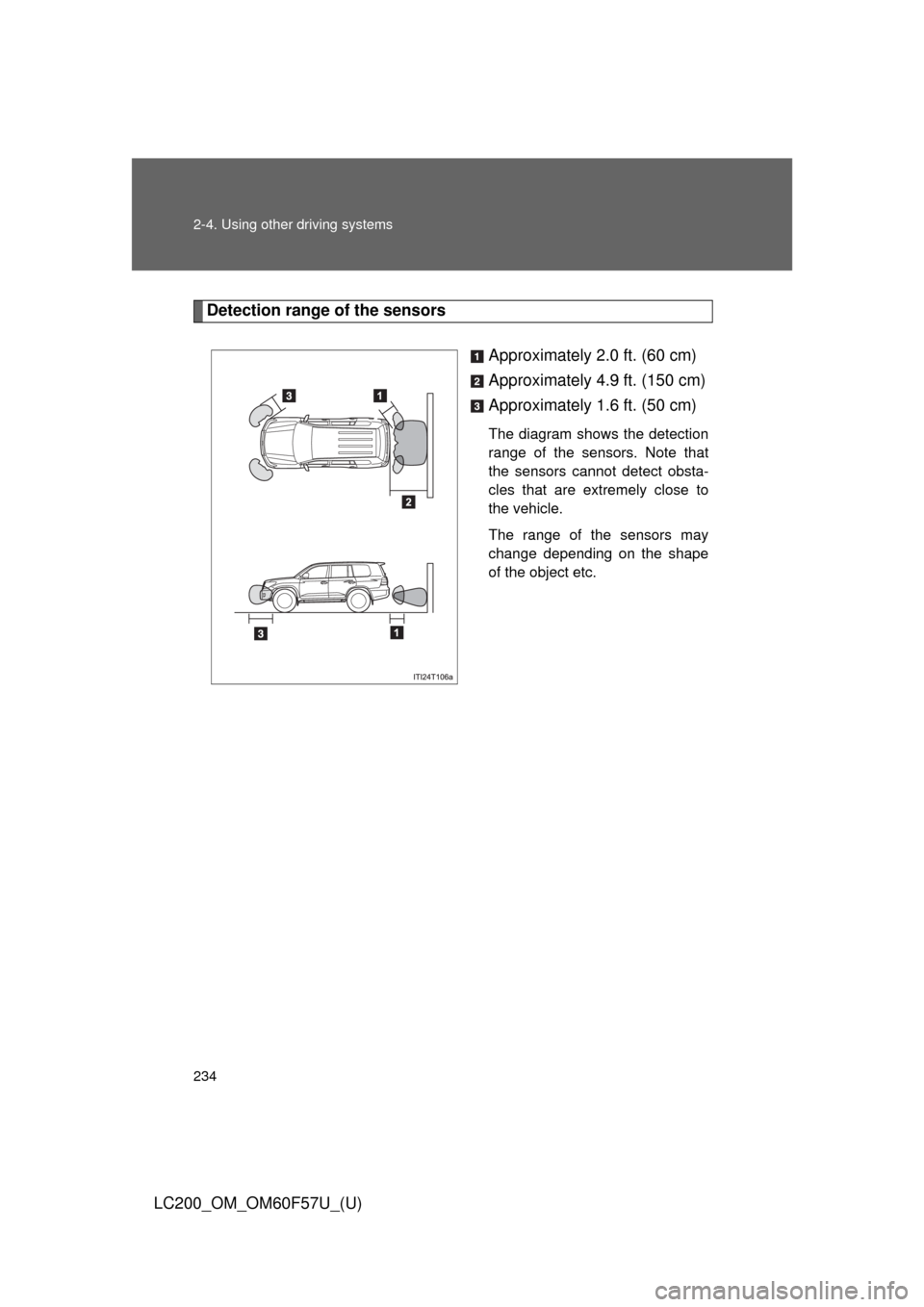
234 2-4. Using other driving systems
LC200_OM_OM60F57U_(U)
Detection range of the sensors
Approximately 2.0 ft. (60 cm)
Approximately 4.9 ft. (150 cm)
Approximately 1.6 ft. (50 cm)
The diagram shows the detection
range of the sensors. Note that
the sensors cannot detect obsta-
cles that are extremely close to
the vehicle.
The range of the sensors may
change depending on the shape
of the object etc.
Page 236 of 720

236 2-4. Using other driving systems
LC200_OM_OM60F57U_(U)■Display on/off setting
On or off can be selected for intuitive parking assist display.
Touch “Display Off”.
When the “Display Off” indicator is turned on, the display of intuitive
parking assist will be off. Touch “Display Off” again to turn the display
of intuitive parking assist on.
Touch “Save”.
■Alert distance setting
Front or rear center sensors display and tone indication can be set.
Touch “Rear”.
Long distance or short distance can be selected.
Touch “Save”.
■The intuitive parking assist can be operated when
●Front corner sensors:
• The “ENGINE START STOP” switch is in IGNITION ON mode.
• The shift lever is in a position other than “P”.
• The vehicle speed is less than approximately 6 mph (10 km/h).
●Rear corner and rear center sensors:
• The “ENGINE START STOP” switch is in IGNITION ON mode.
• The shift lever is in “R”.
■Intuitive parking assist display
When an obstacle is detected while the rear view monitor system, Toyota
parking assist monitor or Multi-terrain Monitor is in use, the warning indicator
will appear in the top right of the screen even if the display setting has been
set to off.
STEP1
STEP2
STEP1
STEP2
Page 237 of 720

237 2-4. Using other driving systems
2
When driving
LC200_OM_OM60F57U_(U)
■Sensor detection information
●The sensor’s detection areas are limited to the areas around the vehi-
cle’s front corner and rear bumpers.
●Certain vehicle conditions and the surrounding environment may affect
the ability of the sensor to correctly detect obstacles. Particular instances
where this may occur are listed below.
• There is dirt, snow or ice on the sensor. (Wiping the sensors will
resolve this problem.)
• The sensor is frozen. (Thawing the area will resolve this problem.)
In especially cold weather, if a sensor is frozen the screen may show
an abnormal display, or obstacles may not be detected.
• The sensor is covered in any way.
• The vehicle is leaning considerably to one side.
• On an extremely bumpy road, on an incline, on gravel, or on grass
• The vicinity of the vehicle is noisy due to vehicle horns, motorcycle
engines, air brakes of large vehicles, or other loud noises producing
ultrasonic waves.
• There is another vehicle equipped with parking assist sensors in the
vicinity.
• The sensor is coated with a sheet of spray or heavy rain.
• The vehicle is equipped with a fender pole or wireless antenna.
• Towing eyelets are installed.
• The bumper or sensor receives a strong impact.
• The vehicle is approaching a tall or curved curb.
• In harsh sunlight or intense cold weather
• The area directly under the bumpers is not detected.
• If obstacles draw too close to the sensor.
• A non-genuine Toyota suspension (lowered suspension etc.) is
installed.
• People may not be detected if they are wearing certain types of cloth-
ing.
In addition to the examples above, there are instances in which, because
of their shape, signs and other objects may be judged by the sensor to be
closer than they are.
Page 238 of 720

238 2-4. Using other driving systems
LC200_OM_OM60F57U_(U)
●The shape of the obstacle may prevent the sensor from detecting it. Pay
particular attention to the following obstacles:
• Wires, fences, ropes, etc.
• Cotton, snow and other materials that absorb sound waves
• Sharply-angled objects
• Low obstacles
• Tall obstacles with upper sections projecting outwards in the direction
of your vehicle
●The following situations may occur during use.
• Depending on the shape of the obstacle and other factors, the detec-
tion distance may shorten, or detection may be impossible.
• Obstacles may not be detected if they are too close to the sensor
• There will be a short delay between obstacle detection and display.
Even at slow speeds, there is a possibility that the obstacle will come
within the sensor’s detection areas before the display is shown and the
warning beep sounds.
• Thin posts or objects lower than the sensor may not be detected for
collision when approached, even if they have been detected once.
• It might be difficult to hear beeps due to the volume of audio system or
air flow noise of air conditioning system.
■If a message is displayed on the multi-information display
P. 617
Page 239 of 720
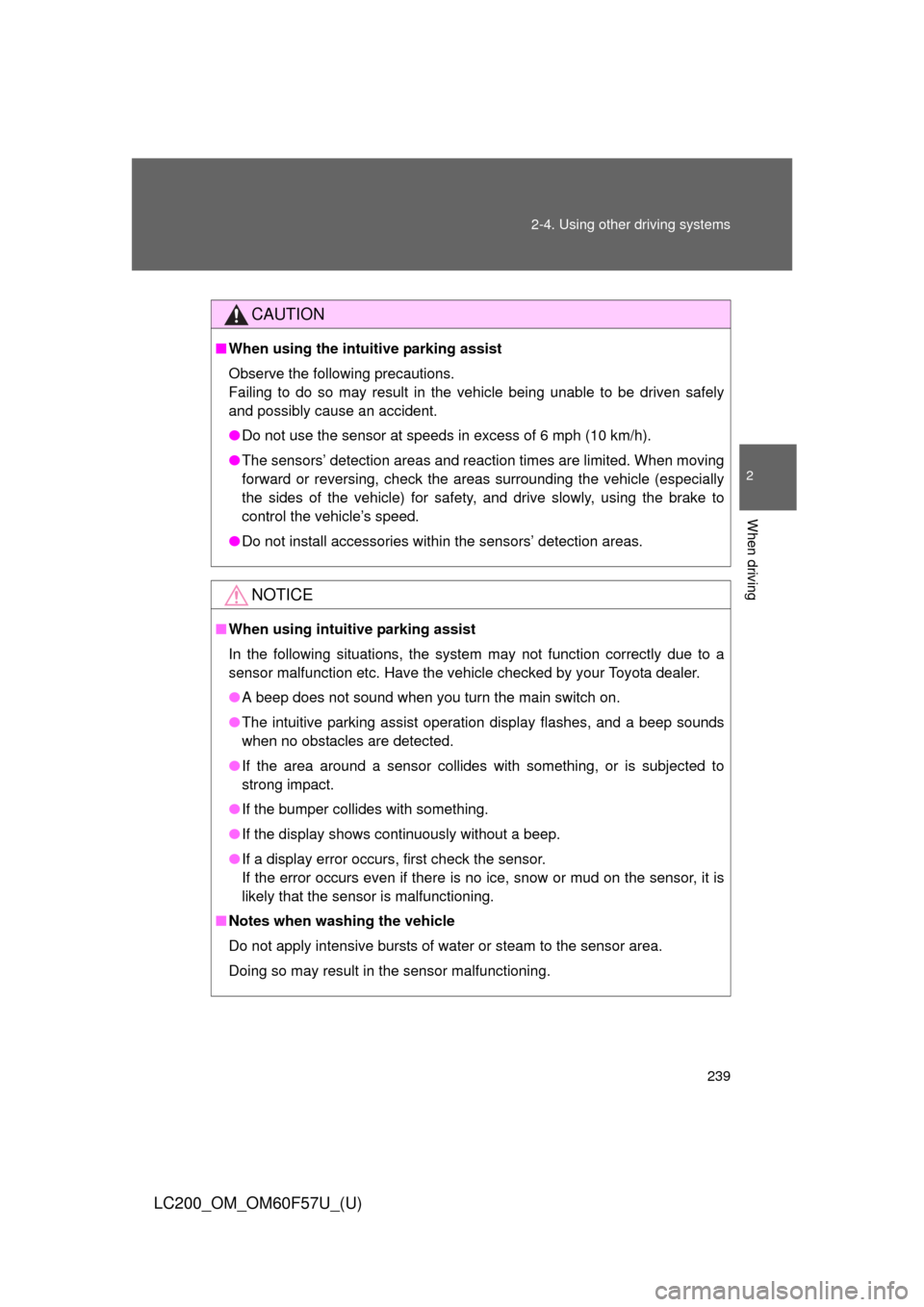
239 2-4. Using other driving systems
2
When driving
LC200_OM_OM60F57U_(U)
CAUTION
■When using the intuitive parking assist
Observe the following precautions.
Failing to do so may result in the vehicle being unable to be driven safely
and possibly cause an accident.
●Do not use the sensor at speeds in excess of 6 mph (10 km/h).
●The sensors’ detection areas and reaction times are limited. When moving
forward or reversing, check the areas surrounding the vehicle (especially
the sides of the vehicle) for safety, and drive slowly, using the brake to
control the vehicle’s speed.
●Do not install accessories within the sensors’ detection areas.
NOTICE
■When using intuitive parking assist
In the following situations, the system may not function correctly due to a
sensor malfunction etc. Have the vehicle checked by your Toyota dealer.
●A beep does not sound when you turn the main switch on.
●The intuitive parking assist operation display flashes, and a beep sounds
when no obstacles are detected.
●If the area around a sensor collides with something, or is subjected to
strong impact.
●If the bumper collides with something.
●If the display shows continuously without a beep.
●If a display error occurs, first check the sensor.
If the error occurs even if there is no ice, snow or mud on the sensor, it is
likely that the sensor is malfunctioning.
■Notes when washing the vehicle
Do not apply intensive bursts of water or steam to the sensor area.
Doing so may result in the sensor malfunctioning.
Page 279 of 720
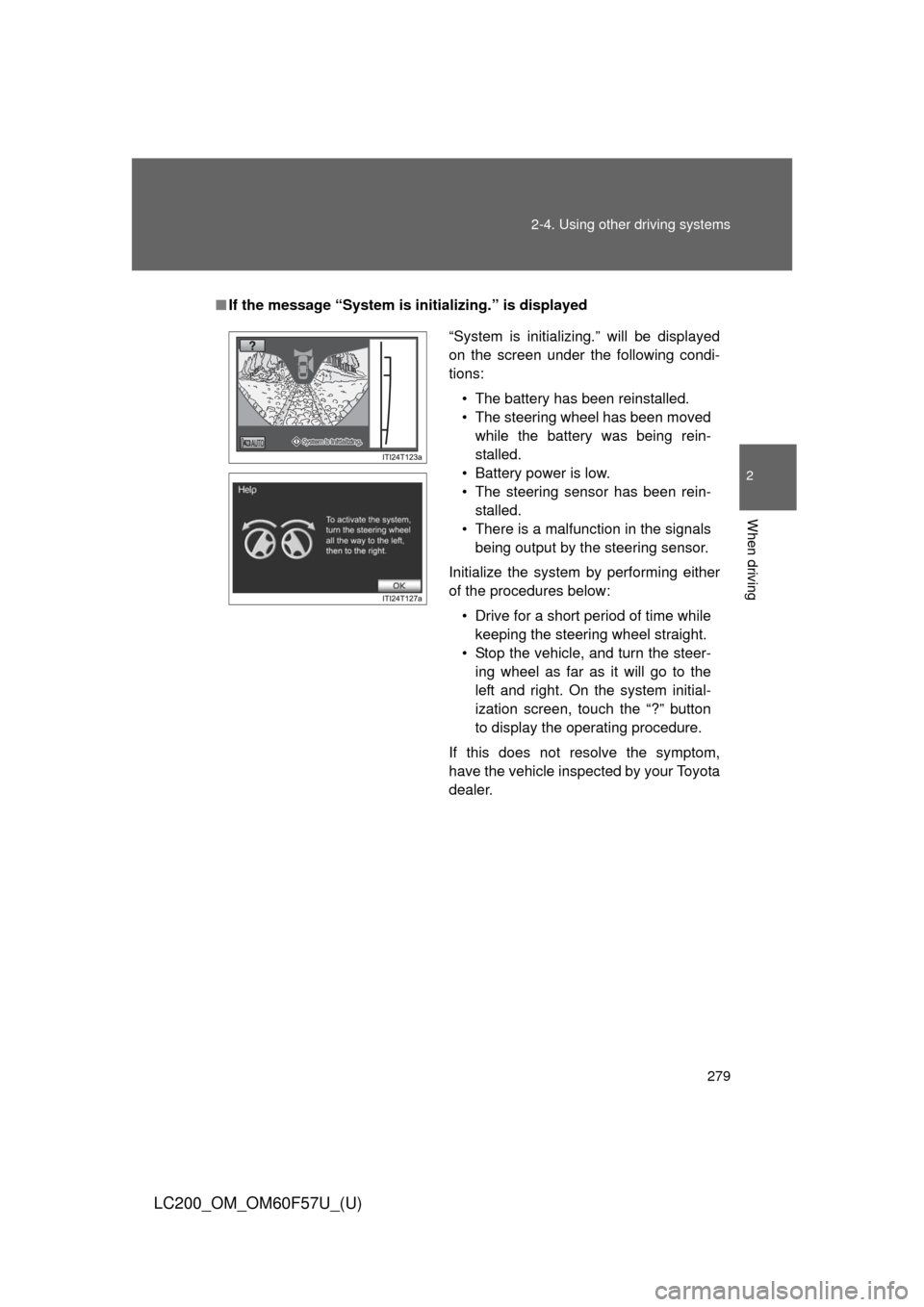
279 2-4. Using other driving systems
2
When driving
LC200_OM_OM60F57U_(U)
■If the message “System is initializing.” is displayed
“System is initializing.” will be displayed
on the screen under the following condi-
tions:
• The battery has been reinstalled.
• The steering wheel has been moved
while the battery was being rein-
stalled.
• Battery power is low.
• The steering sensor has been rein-
stalled.
• There is a malfunction in the signals
being output by the steering sensor.
Initialize the system by performing either
of the procedures below:
• Drive for a short period of time while
keeping the steering wheel straight.
• Stop the vehicle, and turn the steer-
ing wheel as far as it will go to the
left and right. On the system initial-
ization screen, touch the “?” button
to display the operating procedure.
If this does not resolve the symptom,
have the vehicle inspected by your Toyota
dealer.
Page 290 of 720
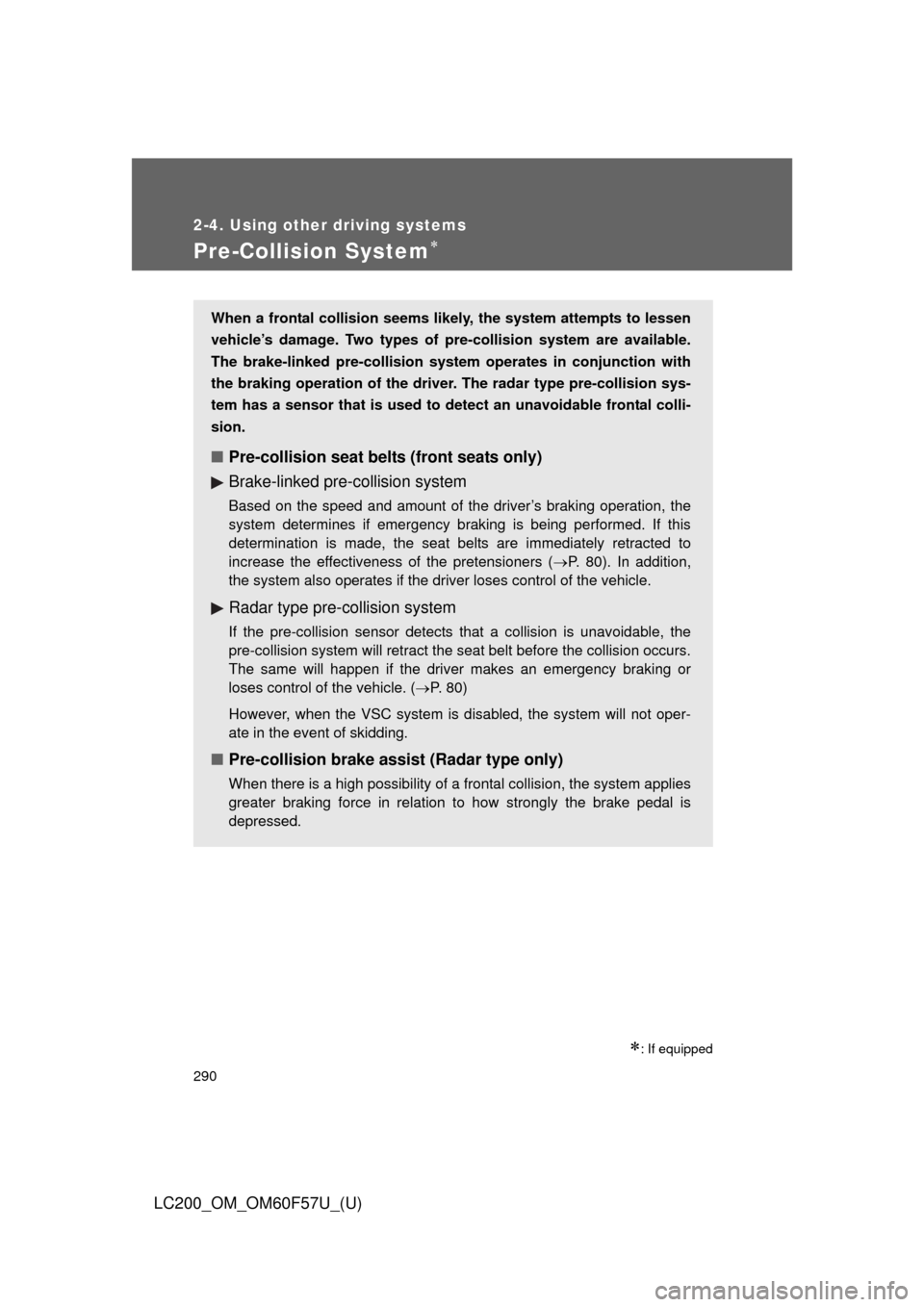
290
2-4. Using other driving systems
LC200_OM_OM60F57U_(U)
Pre-Collision System
: If equipped
When a frontal collision seems likely, the system attempts to lessen
vehicle’s damage. Two types of pre-collision system are available.
The brake-linked pre-collision system operates in conjunction with
the braking operation of the driver. The radar type pre-collision sys-
tem has a sensor that is used to detect an unavoidable frontal colli-
sion.
■Pre-collision seat belts (front seats only)
Brake-linked pre-collision system
Based on the speed and amount of the driver’s braking operation, the
system determines if emergency braking is being performed. If this
determination is made, the seat belts are immediately retracted to
increase the effectiveness of the pretensioners (P. 80). In addition,
the system also operates if the driver loses control of the vehicle.
Radar type pre-collision system
If the pre-collision sensor detects that a collision is unavoidable, the
pre-collision system will retract the seat belt before the collision occurs.
The same will happen if the driver makes an emergency braking or
loses control of the vehicle. (P. 80)
However, when the VSC system is disabled, the system will not oper-
ate in the event of skidding.
■Pre-collision brake assist (Radar type only)
When there is a high possibility of a frontal collision, the system applies
greater braking force in relation to how strongly the brake pedal is
depressed.
Page 291 of 720
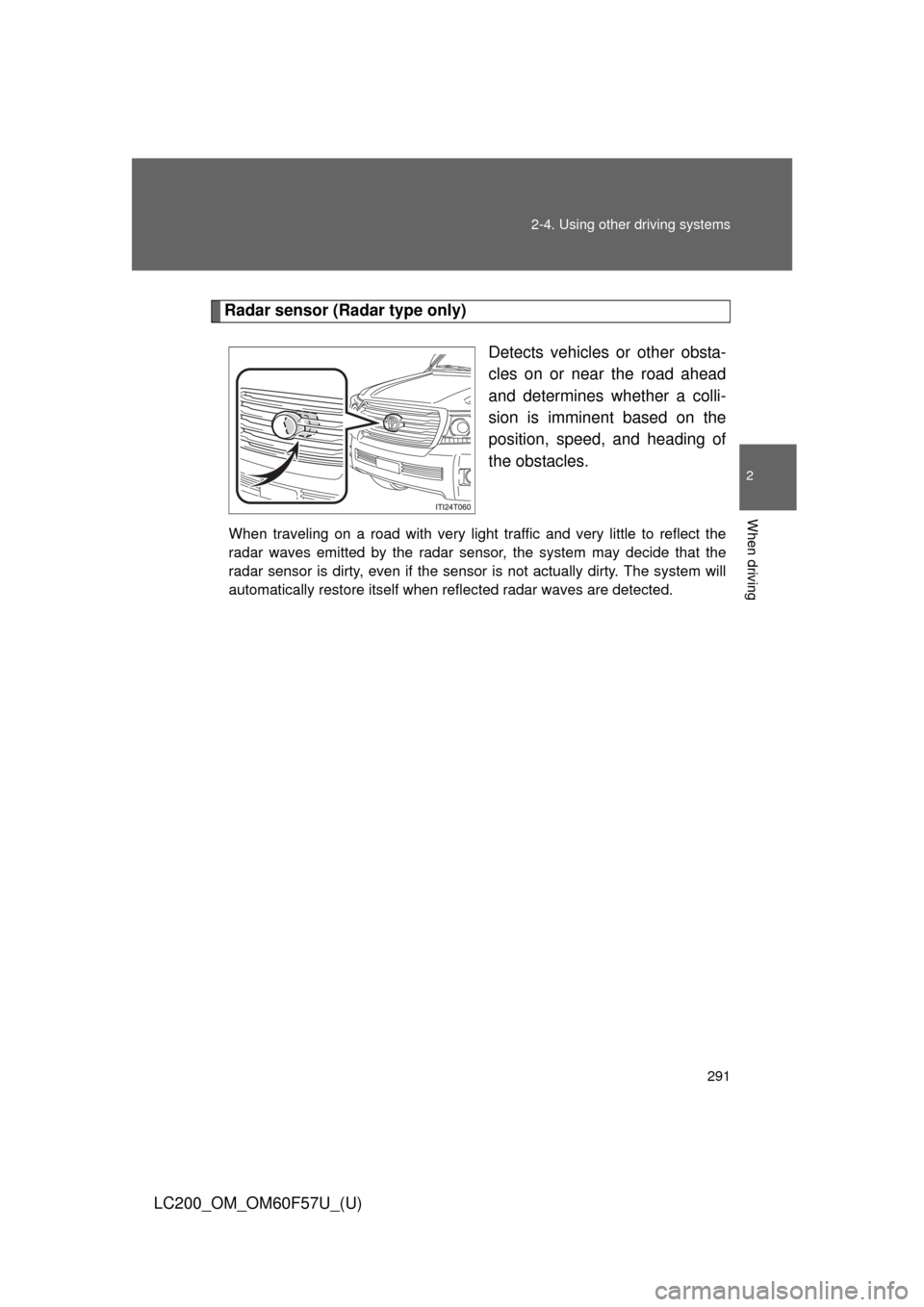
291 2-4. Using other driving systems
2
When driving
LC200_OM_OM60F57U_(U)
Radar sensor (Radar type only)
Detects vehicles or other obsta-
cles on or near the road ahead
and determines whether a colli-
sion is imminent based on the
position, speed, and heading of
the obstacles.
When traveling on a road with very light traffic and very little to reflect the
radar waves emitted by the radar sensor, the system may decide that the
radar sensor is dirty, even if the sensor is not actually dirty. The system will
automatically restore itself when reflected radar waves are detected.
Page 292 of 720

292 2-4. Using other driving systems
LC200_OM_OM60F57U_(U)
■Obstacles not detected (Radar type only)
The sensor cannot detect plastic obstacles such as pylons. There may also
be occasions when the radar sensor cannot detect pedestrians, animals,
bicycles, motorcycles, trees, or snowdrifts.
■The pre-collision system is operational when
●Pre-collision seat belts (situation 1)
• Vehicle speed is greater than about 4 mph (5 km/h).
• The speed at which your vehicle is approaching the obstacle or the
vehicle running ahead of you is greater than about 19 mph (30 km/h).
• The front occupants are wearing a seat belt.
●Pre-collision seat belts (situation 2)
• Vehicle speed is greater than about 19 mph (30 km/h).
• The system detects sudden braking or skidding.
• The front occupants are wearing a seat belt.
●Pre-collision brake assist
• Vehicle speed is greater than about 19 mph (30 km/h).
• The speed at which your vehicle is approaching the obstacle or the
vehicle running ahead of you is greater than about 19 mph (30 km/h).
• The brake pedal is depressed.